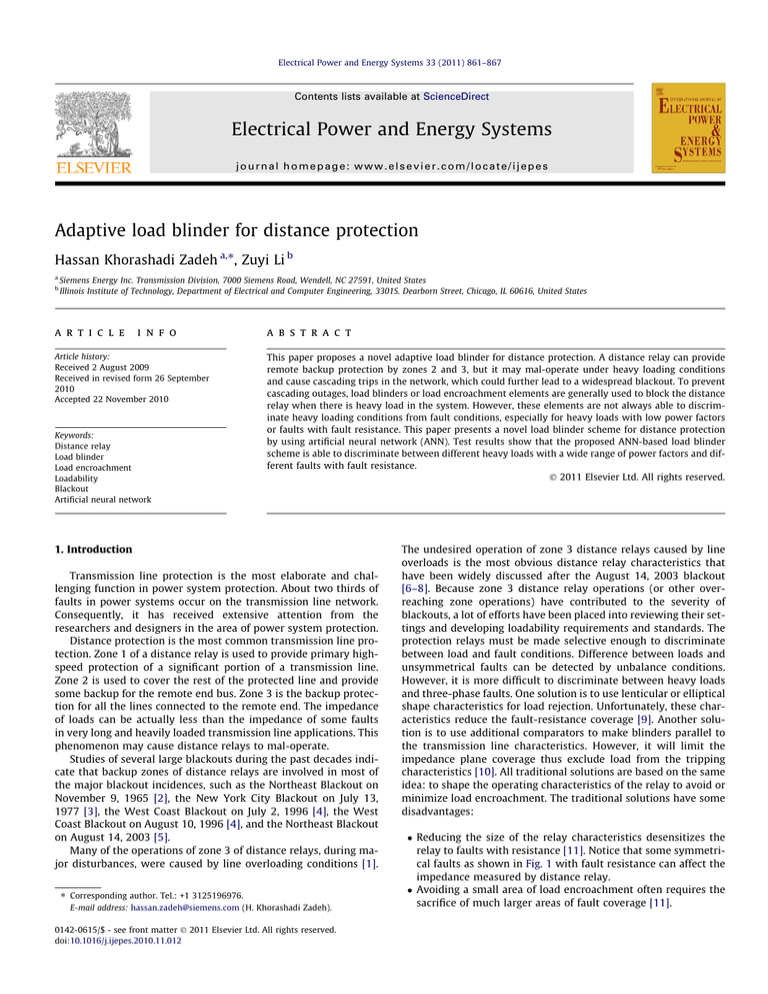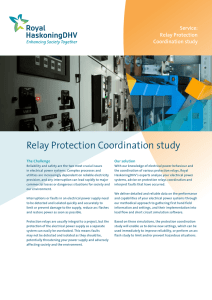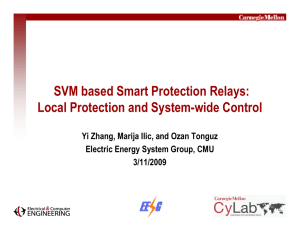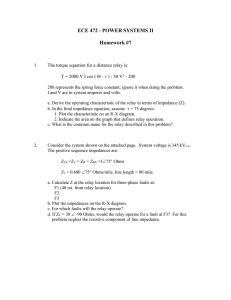
Electrical Power and Energy Systems 33 (2011) 861–867
Contents lists available at ScienceDirect
Electrical Power and Energy Systems
journal homepage: www.elsevier.com/locate/ijepes
Adaptive load blinder for distance protection
Hassan Khorashadi Zadeh a,⇑, Zuyi Li b
a
b
Siemens Energy Inc. Transmission Division, 7000 Siemens Road, Wendell, NC 27591, United States
Illinois Institute of Technology, Department of Electrical and Computer Engineering, 3301S. Dearborn Street, Chicago, IL 60616, United States
a r t i c l e
i n f o
Article history:
Received 2 August 2009
Received in revised form 26 September
2010
Accepted 22 November 2010
Keywords:
Distance relay
Load blinder
Load encroachment
Loadability
Blackout
Artificial neural network
a b s t r a c t
This paper proposes a novel adaptive load blinder for distance protection. A distance relay can provide
remote backup protection by zones 2 and 3, but it may mal-operate under heavy loading conditions
and cause cascading trips in the network, which could further lead to a widespread blackout. To prevent
cascading outages, load blinders or load encroachment elements are generally used to block the distance
relay when there is heavy load in the system. However, these elements are not always able to discriminate heavy loading conditions from fault conditions, especially for heavy loads with low power factors
or faults with fault resistance. This paper presents a novel load blinder scheme for distance protection
by using artificial neural network (ANN). Test results show that the proposed ANN-based load blinder
scheme is able to discriminate between different heavy loads with a wide range of power factors and different faults with fault resistance.
Ó 2011 Elsevier Ltd. All rights reserved.
1. Introduction
Transmission line protection is the most elaborate and challenging function in power system protection. About two thirds of
faults in power systems occur on the transmission line network.
Consequently, it has received extensive attention from the
researchers and designers in the area of power system protection.
Distance protection is the most common transmission line protection. Zone 1 of a distance relay is used to provide primary highspeed protection of a significant portion of a transmission line.
Zone 2 is used to cover the rest of the protected line and provide
some backup for the remote end bus. Zone 3 is the backup protection for all the lines connected to the remote end. The impedance
of loads can be actually less than the impedance of some faults
in very long and heavily loaded transmission line applications. This
phenomenon may cause distance relays to mal-operate.
Studies of several large blackouts during the past decades indicate that backup zones of distance relays are involved in most of
the major blackout incidences, such as the Northeast Blackout on
November 9, 1965 [2], the New York City Blackout on July 13,
1977 [3], the West Coast Blackout on July 2, 1996 [4], the West
Coast Blackout on August 10, 1996 [4], and the Northeast Blackout
on August 14, 2003 [5].
Many of the operations of zone 3 of distance relays, during major disturbances, were caused by line overloading conditions [1].
⇑ Corresponding author. Tel.: +1 3125196976.
E-mail address: hassan.zadeh@siemens.com (H. Khorashadi Zadeh).
0142-0615/$ - see front matter Ó 2011 Elsevier Ltd. All rights reserved.
doi:10.1016/j.ijepes.2010.11.012
The undesired operation of zone 3 distance relays caused by line
overloads is the most obvious distance relay characteristics that
have been widely discussed after the August 14, 2003 blackout
[6–8]. Because zone 3 distance relay operations (or other overreaching zone operations) have contributed to the severity of
blackouts, a lot of efforts have been placed into reviewing their settings and developing loadability requirements and standards. The
protection relays must be made selective enough to discriminate
between load and fault conditions. Difference between loads and
unsymmetrical faults can be detected by unbalance conditions.
However, it is more difficult to discriminate between heavy loads
and three-phase faults. One solution is to use lenticular or elliptical
shape characteristics for load rejection. Unfortunately, these characteristics reduce the fault-resistance coverage [9]. Another solution is to use additional comparators to make blinders parallel to
the transmission line characteristics. However, it will limit the
impedance plane coverage thus exclude load from the tripping
characteristics [10]. All traditional solutions are based on the same
idea: to shape the operating characteristics of the relay to avoid or
minimize load encroachment. The traditional solutions have some
disadvantages:
Reducing the size of the relay characteristics desensitizes the
relay to faults with resistance [11]. Notice that some symmetrical faults as shown in Fig. 1 with fault resistance can affect the
impedance measured by distance relay.
Avoiding a small area of load encroachment often requires the
sacrifice of much larger areas of fault coverage [11].
862
H. Khorashadi Zadeh, Z. Li / Electrical Power and Energy Systems 33 (2011) 861–867
Trip
V
Timer Zone 3
Zone 3
I
Trip
Zone 2
Timer Zone 2
Fig. 1. Symmetrical fault with fault resistance.
Balance Condition
Power factor may not always be a sure indicator that a load
rather than a fault exists on the line [1] if significant amounts
of VARs are being transmitted under unusual system conditions.
2. The proposed neural network based load blinder
The structure of a distance relay with the proposed load blinder
is shown in Fig. 2. In this scheme, a conventional three-zone distance relay is used to detect faults. To prevent the second and
the third zones from undesired trip due to heavy load, an ANNbased load blinder is used. Load blinder will be activated only
when the condition is balanced. By using suitable functions of voltage and current as inputs, the load blinder is able to discriminate
between faults and heavy loads and accordingly block distance relay operation during heavy loads [16].
2.1. Balancing condition check
A heavy load can be considered as a balancing condition. Therefore there is no loadability concern if a condition is unbalanced,
such as an unbalance fault (single phase, phase to phase). To detect
balancing conditions, the negative-sequence current is compared
V
I
Fig. 2. The structure of the proposed scheme.
with a threshold (0.1 p.u. on a base of 1500 A in this paper). A condition is detected as a balancing condition if the negative-sequence
current is less than the threshold.
2.2. ANN-based load blinder
The block diagram of the proposed ANN-based load blinder
scheme is shown in Fig. 3. The details are discussed as follows.
2.2.1. Preprocessing
The input current and voltage signals to the preprocessing module are sampled at 1 kHz. A 2-sample FIR digital filter removes the
dc component, which enhances the training capabilities of the
ANN. Next the full cycle discrete Fourier transform (DFT) algorithm
is applied to obtain the phasors (including magnitudes and angles)
of voltage and current signals. The preprocessing stage can significantly reduce the size of the neural networks based classifiers,
which in turn improves the performance and speed of the training
process [17].
2.2.2. ANN inputs
One of the keys to the success of any ANN application is the
choice of input signals. After analyzing different factors such as
current and voltage magnitudes, impedance, change rate of voltage, current, and power, we have chosen active power, reactive
power, voltage, the change rate of phase A voltage, and the change
rate of phase A current as input signals to ANN. The change rate of
voltage and current are defined as follows:
DIA ¼ IA ðnÞ IA ðpÞ
ð1Þ
DV A ¼ V A ðnÞ V A ðpÞ
ð2Þ
P
V
I
Preprocessing
Protection relaying is just as much a candidate for the application of pattern recognition techniques. The majority of power system protection techniques involve the definition of system states
through identifying the pattern of the associated voltage and current waveforms measured at the relay location. This means that
the development of adaptive protection can be essentially treated
as a problem of pattern recognition or classification, for which artificial intelligence (AI) based techniques are powerful. AI possesses
excellent features such as generalization capability, noise immunity, robustness, and fault tolerance. Consequently, the decision
made by an AI-based relay will not be seriously affected by variations in system parameters. AI-based techniques have been used in
power system protection and encouraging results have been obtained [12–15].
In this paper, a new scheme is proposed for designing an accurate and reliable load blinder. The proposed scheme is based on
artificial neural network (ANN). Various power system scenarios
are modeled and an ANN based algorithm is used for the recognition of these patterns. Performance of the proposed scheme is evaluated under various conditions and encouraging results are
obtained. It is shown that the algorithm is able to perform correctly
for different combinations of conditions, e.g., fault resistances, fault
locations, pre-fault power flow directions, source impedance ratios, and load power factors.
The rest of the paper is organized as follows. Section 2 presents
the structure of the proposed ANN-based load blinder. Test results
of the proposed scheme are demonstrated in Section 3. Section 4
concludes the paper.
ANN based Load
Blinder
Q
V
ΔV
Artificial
Neural
Network
Output
ΔI
Fig. 3. The structure of ANN-based load blinder.
ID
400092
Title
Adaptiveloadblinderfordistanceprotection
http://fulltext.study/article/400092
http://FullText.Study
Pages
7



